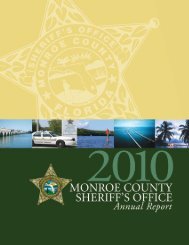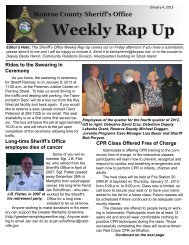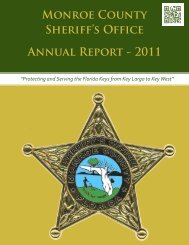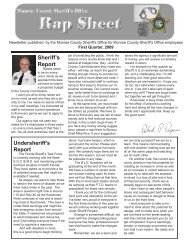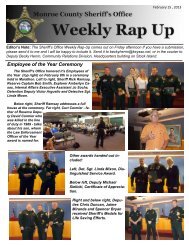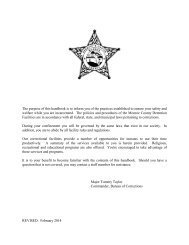Annual Report, Year 2006 - Monroe County Sheriff's Office
Annual Report, Year 2006 - Monroe County Sheriff's Office
Annual Report, Year 2006 - Monroe County Sheriff's Office
You also want an ePaper? Increase the reach of your titles
YUMPU automatically turns print PDFs into web optimized ePapers that Google loves.
<strong>Monroe</strong> <strong>County</strong> Sheriff’s <strong>Office</strong> <strong>Annual</strong> <strong>Report</strong> - <strong>2006</strong><br />
staff and medical flight crew.<br />
The new aircraft is a Sikorsky S-76 helicopter with a medical package configuration. The <strong>County</strong> Commission<br />
purchased the aircraft from a Pennsylvania hospital group. To help offset the expenses of the operation,<br />
the Sheriff’s <strong>Office</strong> applied for an FAA Part 135 Operational Certificate which will allow for the collection of<br />
fees for services provided. This license requires compliance with extensive regulations and more frequent and<br />
intensive inspections. Rules also outline specific training required for all pilots, mechanics and medical flight<br />
crew.<br />
The new operation is a successful merger of three primary groups – the <strong>Monroe</strong> <strong>County</strong> Commission and<br />
<strong>County</strong> Administrator, <strong>Monroe</strong> <strong>County</strong> Fire / Rescue and the <strong>Monroe</strong> <strong>County</strong> Sheriff’s <strong>Office</strong>. The leadership,<br />
vision, direction and commitment of the leaders of these organizations has made it possible for the citizens and<br />
guests of <strong>Monroe</strong> <strong>County</strong> to benefit from this service. The <strong>Monroe</strong> <strong>County</strong> Sheriff’s <strong>Office</strong> considers it an honor<br />
to operate and maintain the helicopter and to work with the outstanding men and<br />
women from Fire / Rescue and the hospitals of <strong>Monroe</strong> <strong>County</strong>.<br />
Community Relations Division<br />
The goal of the Community Relations Division is to prevent crime and enhance<br />
safety in the Florida Keys, which is accomplished through the Division’s various<br />
programs and through education of the public.<br />
The Community Relations Division is comprised of:<br />
• The Public Information <strong>Office</strong>r, who keeps the public informed about criminal<br />
Director Greg Artman activity, safety measures and events happening at the Sheriff’s <strong>Office</strong>.<br />
• School Resource <strong>Office</strong>rs, who are assigned to area schools to not only enforce<br />
the law but to teach students to avoid criminal behavior and drug abuse.<br />
• The Crime Watch Coordinator, who organizes and guides neighborhood crime watch groups to be the<br />
“eyes and ears” of law enforcement and instructs them on how to avoid being victims of crime.<br />
• The Crime Stoppers program, which helps law enforcement by offering rewards for information about<br />
crime. An anonymous hot line forwards tips to local law enforcement.<br />
• The Juvenile Programs Division, which focuses on youthful offenders to prevent them from becoming<br />
adult offenders through education and hands on guidance. The School Crossing Guards program, which<br />
helps keep children safe when they arrive and leave their schools, either on foot or in vehicles.<br />
Teen Court<br />
The Sheriff’s Teen Court program successfully closed 135 cases in <strong>2006</strong>, which is almost a ninety percent<br />
rate of success for teens entering this nationally acclaimed diversion program. Teen Court is designed to divert<br />
less serious offenders away from juvenile court so that these first or second time offenders don’t get a criminal<br />
record, yet still face consequences for their actions. Just one<br />
criminal offense on the record could hinder a youth from college<br />
admission, military service, or a career path.<br />
Youth are referred to the program in several ways, including<br />
the issuance of juvenile citations by law enforcement officers or<br />
referrals from the State Attorney’s <strong>Office</strong> or from the Department<br />
of Juvenile Justice. If the youthful offender is eligible for the<br />
program, he or she must admit guilt and accept responsibility<br />
in order to be accepted. Teen Court only decides on the consequences<br />
of the offense, which could include community service,<br />
serving as a juror on other student’s cases, essays, jail tours,<br />
apologies to their victims and /or their parents, counseling, drug<br />
screening, and, restitution. Teen Court is based on the premise<br />
that youthful offenders will more readily accept responsibility for<br />
their actions when judged by their peers. The youthful offenders<br />
who successfully complete all of the sanctions handed down by<br />
their peers usually have thirty to ninety days to complete them. If the youth successfully completed the program,<br />
charges are dropped. If the youth fails to complete the sanctions, the case is referred back to the court<br />
system for prosecution.<br />
Many teens volunteer to work with the program. Teen Court allows volunteer youth the opportunity to<br />
46<br />
The Sheriff’s Juvenile Programs Division<br />
handles IDDS and Teen Court.




